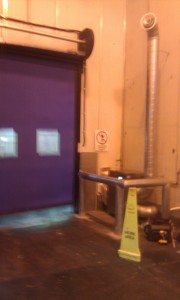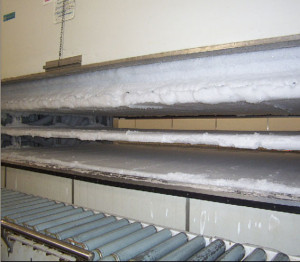Control of Moisture – The road to Product quality
A great deal of water is used during the cleaning process of the production and packaging areas within a slaughter house. If left to lie on the floor or machine surfaces, this water will be held in the air as water vapour. Add to this the ambient air being introduced by the ventilation system, normally much higher during the hotter summer months, then we have a great deal of moisture contained in the air of the production unit. This moisture can only be held in the air above a given temperature. If this air comes into contact with a surface which is below its dewpoint, such as in a cold room, the natural result will be the formation of condensation (dew) on these surfaces.
Free from condensation, mould and bacteria Reducing the water content of the air lowers its dewpoint, that is the temperature at which it will form condensation. Providing the water content is reduced sufficiently, cold surfaces (machinery, floors, walls and ceilings ) will remain dry. Hygiene and safety standards will be improved. The formation of mould and bacteria will be eliminated.
The solution – a desiccant dehumidifier.
Shorter production stoppages
The normal way of drying the premises after cleaning is to squeegee the floor, mop up any excess water and use ventilation to assist the process. Using a sorption dehumidifier for cleaning and drying premises shortens the time required to dry ceilings, walls and machinery, resulting in shorter production stoppages so that work can be resumed more quickly.
Better working environment
Controlled humidity creates a drier climate and a more pleasant working environment despite the low temperature. Reduced humidity also helps eliminate odours and the risks of slipping on wet surfaces.
HACCP and controlled moisture
Work is facilitated by controlled humidity at packaging and production facilities, and hygiene levels are assured thanks to HACCP (Hazard Analysis and Critical Control Points).
- Better Hygene – Low controlled humidity on the premises prevents multiplication of mould and bacteria
- Hygiene is improved as ceilings, walls and machinery remain dry
The premises dry more quickly after cleaning - There is less need for repeated cleaning
- Staff do not need to wipe down production machinery manually, so resulting in greater uptime
- Compliance with authority requirements is easier if low, controlled humidity is maintained
CASE : Simplot Bathurst loading dock to maintain 0Cdp at 15C blowing -30Cdp at doorway
CASE : Moemeat frost prevention with -40Cdp for frost prevention



